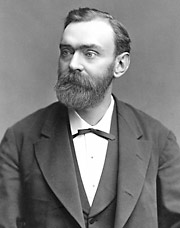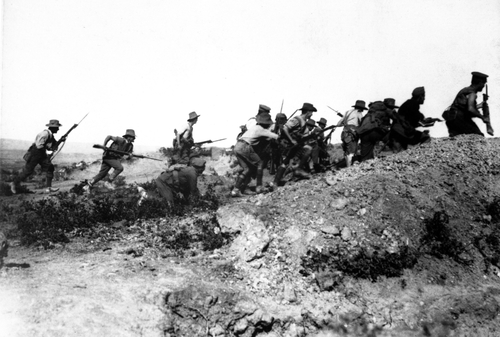The Great War or the 1st World War as it is also known, was the first war to take place around the world, to result in millions of casualties and to involve many of the civilians in the warring countries. Chemists and chemistry were involved from the start.
Men responded to the call to arms and chemists were amongst them. Ernest Rutherford’s team at Manchester University which had explored the structure of the atom began to disperse. Henry Moseley joined the British Army in the Royal Engineers and died in Turkey in 1915. Hans Geiger, who had returned to Germany in 1912 served in the German artillery. Rutherford himself worked on ways of tracking submarines.
In France, Marie Curie gave up her work with radium to organise a fleet of mobile X-ray units which she took to the battle lines with her daughter Irene. German radio-chemist and co-discoverer of protactinium, Lise Meitner also worked as an X-ray nurse during the war while her long-time research partner, Otto Hahn, was conscripted into the German army to work on chemical weapons.
Explosives

Gunpowder had been used in war for centuries but the Great War was the first major war in which a range of high explosives developed in the nineteenth century was used so destructively. Alfred Nobel developed dynamite (1867) and gelignite (1876) by combining highly unstable compounds such as nitro-glycerin with unreactive materials making them safe enough to transport. Nobel intended his explosives as an aid to quarrymen and miners. He was dismayed that he became known for getting rich by finding better ways to kill people. As a result when he died he gave all his wealth to the establishment of the Nobel prizes.
TNT (tri-nitro-toluene) was first prepared in 1863 by the German, Julius Wilbrand. It turned out to be one of the most useful and powerful explosives and is the explosive that others are compared with. In the first decade of the twentieth century, the German and British armies started to use TNT instead of gunpowder in artillery shells.
Preparing the explosives was a massive industrial task and one that during the war was done largely by women. As well as the risk of explosions the women also had to face other dangers in handling the chemicals. Their skin turned yellow giving them the nickname the Canary Girls but the effects also included liver damage, anaemia and loss of fertility.
Nitric Acid and Fritz Haber
Nitric acid is an essential reactant in making explosives such as TNT. Until the Great War nitric acid was obtained from naturally occurring nitrates particularly found in Chile, South America. Nitrates were of course also needed as fertilisers and it was recognised that the natural resources would not last for ever. By the outbreak of war, German chemists, Fritz Haber, Carl Bosch and Friedrich Ostwald, had developed methods of making first ammonia and then nitric acid using nitrogen from the air and water.
Early in the war, sea battles in the Pacific cut off supplies of Chilean nitrates to Germany. The war continued however, because Germany was able to manufacture its own nitric acid and hence the explosives its forces needed. Controversially, Fritz Haber was awarded the Nobel Prize in 1918 for his process for making ammonia because it was recognised that this new source of fertiliser would help feed the world. After the war, the secrets of Haber’s process were used by the victorious allies to develop their fertiliser industries.
Armour
As explosives became more powerful so thicker and more effective armour was needed and in the Great War that meant steel. For the first time soldiers were given steel helmets to offer some protection from rifle and machine gun fire. The 1st World War saw the first large-scale naval battles between iron ships powered by steam. Throughout the war the coal mines and steelworks of the industrialised countries competed to provide the fuel and materials for ships and railways and guns. Huge amounts of iron ore had to be imported from overseas. Britain’s biggest supplier was Spain.
Other metals and alloys, such as stainless steel, were also called upon and were developed during the war.
Fuels
The Great War was the first in which the internal combustion engine played an important role. Cars and lorries replaced horses and carts for many uses and later in the war, tanks transformed the battlefield. Aircraft which also used internal combustion engines developed rapidly as fighters and bombers. Diesel engines began to replace steam in battleships.
These engines required liquid fuels – petrol, kerosene and diesel – which had to be refined from crude petroleum. Britain was supplied with crude oil from Persia (now Iran) while Germany pushed a railway line through Turkish territory to reach the oil of what is now Iraq. The British captured this oil field in 1917 and Germany then had to rely on supplies from Romania.
Airships
The first bombing raid on London was carried out by a German airship built by the Zeppelin Company. Airships had a rigid framework made of aluminium alloy. Hydrogen gas which gave the airship lift was held in bags made of cotton coated with rubber although cow intestines were also used. Hydrogen was produced by reacting water with heated iron or a mixture of sodium hydroxide and an iron/silicon mixture. Although hydrogen is very flammable it proved quite

difficult for defenders to shoot down Zeppelins until bullets containing phosphorus were used. The phosphorus ignited in the air and set the hydrogen alight. It was recognised that helium would be a safer gas for filling airships but there was not enough available at the time.
Zeppelin bombing raids did not kill a large number of people but it was the first time that citizens a long way from the battlefronts had been targeted. The raids produced great terror.
Chemical weapons
Everything is made of chemicals and chemistry is needed to make bullets and bombs but the term “chemical weapons” is reserved for substances that kill or injure not by exploding or burning but because of their toxic properties. Both sides in the Great War looked for suitable substances but it was Germany that made the first large-scale use of a poison gas. The weapon was very simple – the element chlorine. Chlorine gas irritates the eyes, nose, throat and lungs and at high concentration the damage results in death. Chlorine gas is denser than air so would sink into the trenches but it was easily dispersed by a strong wind. It was therefore not a very reliable weapon. In fact when the British responded with their own chlorine attack it blew back and harmed more of their own soldiers than the enemy.
The idea of using chlorine was Fritz Haber’s, the head of the German Chemical Warfare Service. He developed the means of delivering the gas and supervised its first use. Chlorine however was not a very satisfactory weapon as it was so dependent on the weather conditions, but there were other deadlier materials.
Phosgene, COCl2, was discovered by John Davy (brother of Humphry Davy) in 1812. Unlike chlorine it is colourless and its odour is almost undetectable. It attacks the alveoli in the lungs. It was first used by the French but later by Germany and was an effective weapon killing over 80,000 people during the war.

The chemical weapon that was most feared however was mustard gas, (CH2ClCH2)2S. This was a dense gas that condensed to form an oily liquid that could stay in the mud of the trenches for days. If it touches the skin or the eyes or enters the lungs it first causes itching then blisters which break and bleed and cause agony for the wounded. The burns take months to heal and later can cause cancer. Only a small percentage of those affected died but many were incapacitated and required a lot of medical help. The value of mustard gas was not the deaths it caused but the disruption and fear in the enemy. Mustard gas was developed by Haber’s team and first used by the Germans in July 1917. The British responded in November 1917 using captured German mustard gas shells.
During the war there were over a million casualties of chemical weapons of whom about 90,000 died. This was a small fraction of the total number of deaths in the war.The horrors caused by chemical weapons lead to the Geneva Protocol in 1925 which banned their use in war. Nevertheless in the 2nd World War people feared the use of poison gases and everyone was issued with gas masks.
During the war both sides used all the resources they could muster to continue the fighting. All the industry and science available to the warring countries was used. Chemistry and chemists were not to blame for the war but they contributed to the deaths and destruction.
Activities
- The names of a number of chemists appear in the article. Find out more about their lives and work.
- Suggest reasons why the war in Europe became a world war.
- Discuss the reasons for and against the award of the Nobel Prize to Fritz Haber.
- Why is the use of chemical weapons in warfare banned but the use of explosives is not?
- “People make war, not science.” Discuss the role of chemistry in warfare.
Peter Ellis



